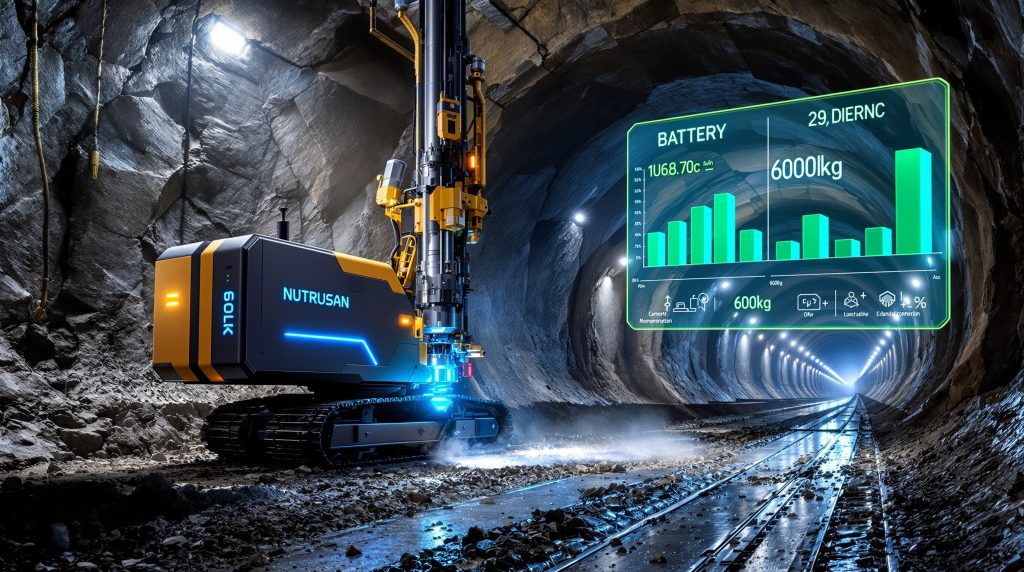Underground mining has witnessed a revolutionary advancement with the introduction of battery-powered cable bolters, marking a fundamental shift from traditional diesel-powered equipment to advanced electric alternatives. These sophisticated machines represent the convergence of lithium battery technology, automated drilling systems, and zero-emission operations in challenging underground environments. Furthermore, this technology addresses longstanding safety concerns while delivering enhanced operational efficiency.
Understanding Battery-Electric Rock Reinforcement Technology
Battery-powered cable bolters integrate several critical technological components that distinguish them from conventional diesel models. The primary powerhouse lies in lithium-iron phosphate (LFP) battery systems, which replace traditional combustion engines entirely. These battery packs deliver consistent power output while maintaining thermal stability in underground conditions where temperature fluctuations can impact equipment performance.
The integrated cement mixing and grouting capabilities represent another significant advancement. Modern electric cable bolters feature on-board automatic cement mixers paired with substantial cement storage silos, typically holding 600 kilograms of material. This configuration reduces manual handling requirements and maintains consistent cement batch quality throughout drilling operations.
Advanced drilling mechanisms incorporate precision control systems that enable accurate cable bolt installation at depths reaching up to 25 meters. The drilling assemblies utilise automated positioning technology to ensure consistent hole placement and proper bolt alignment for optimal rock reinforcement effectiveness.
Digital control systems and automation features form the technological backbone of these machines. Integrated monitoring platforms track drilling parameters, battery performance, equipment health diagnostics, and operational metrics in real-time. These systems enable predictive maintenance scheduling and performance optimisation through continuous data analysis.
Key Performance Specifications
| Feature | Capability |
|---|---|
| Cable bolt length capacity | Up to 25 meters |
| Battery operation duration | 4+ hours continuous off-grid |
| Cement silo capacity | 600 kilograms |
| Visibility improvement | 55% enhanced cabin design |
| Steel strand installation | Multiple strands per hole |
| Charging technology | Patented charging while drilling |
How Do Battery-Powered Cable Bolters Improve Underground Safety?
Underground mining safety receives substantial enhancement through the implementation of battery-powered cable bolters, primarily through the elimination of combustion-related hazards and improved operational visibility. These machines address multiple safety concerns that have traditionally challenged underground mining operations.
Zero-Emission Operations Underground
The complete elimination of diesel exhaust represents the most significant safety advancement provided by battery-powered cable bolters. Traditional diesel equipment generates substantial exhaust emissions containing carbon monoxide, nitrogen oxides, and particulate matter that accumulate in confined underground spaces. Battery-electric systems produce zero emissions during tramming, drilling, bolting, and grouting operations, creating safer breathing environments for underground personnel.
Reduced ventilation requirements follow naturally from emission elimination. Underground mines typically invest heavily in ventilation infrastructure to manage air quality when diesel equipment operates in confined spaces. Battery-powered systems significantly reduce ventilation system loads, allowing mines to optimise air management strategies and reduce energy consumption associated with ventilation operations.
Lower heat generation improves working conditions substantially compared to diesel engines, which generate considerable thermal energy during operation. Electric drivetrains operate with higher efficiency ratings and produce minimal waste heat, maintaining more stable underground temperatures and reducing thermal stress on both equipment and personnel.
Decreased noise pollution enhances communication safety throughout underground operations. Electric motors generate substantially less operational noise than diesel engines, improving verbal communication clarity between operators and support personnel. Enhanced communication directly correlates with improved safety coordination during drilling and bolting activities.
Enhanced Operator Protection Features
Tele-remote operation capabilities enable operators to control drilling and bolting functions from locations removed from immediate work zones. This technology reduces direct exposure to hazardous drilling areas and unstable rock conditions that may exist during cable bolt installation. Remote operation proves particularly valuable in emergency rehabilitation scenarios where rock stability remains uncertain.
Automated drilling cycles minimise manual exposure through predetermined operational sequences that execute with minimal operator intervention. One-hole automation systems initiate drilling, maintain proper positioning, control depth parameters, and complete installation cycles with reduced hands-on requirements from operators.
Improved cabin visibility addresses situational awareness through enhanced sightline design. Modern battery-powered cable bolters feature cabin configurations with 55% increased visibility compared to predecessor models, enabling operators to maintain better awareness of drilling operations and surrounding underground conditions.
Reduced vibration and noise exposure benefit operator health through electric drivetrain characteristics that generate lower mechanical vibration and acoustic emissions compared to diesel engines. Prolonged exposure to high vibration and noise levels contributes to occupational health concerns, making these reductions valuable for long-term operator wellbeing.
What Makes Lithium-Iron Phosphate Batteries Ideal for Mining Applications?
Lithium-iron phosphate battery chemistry provides unique advantages specifically suited to the demanding operational requirements of underground mining environments. This battery technology addresses critical performance, safety, and reliability concerns that traditional lead-acid or other lithium formulations cannot adequately manage in mining applications.
Battery Chemistry Advantages
Superior thermal stability represents the primary advantage of LFP chemistry in underground environments. The electrochemical composition of lithium-iron phosphate batteries maintains stable performance across temperature ranges encountered in deep underground operations, where ambient temperatures may fluctuate significantly based on depth, ventilation patterns, and seasonal conditions.
Extended cycle life reduces replacement frequency substantially compared to other battery technologies. LFP batteries typically deliver thousands of charge-discharge cycles while maintaining acceptable capacity retention, translating to reduced downtime for battery replacement and lower total cost of ownership over equipment lifecycles.
Enhanced safety profile with lower fire risk addresses critical underground safety concerns. LFP chemistry exhibits reduced thermal runaway risk compared to other lithium battery formulations, particularly important in enclosed underground spaces where fire suppression and evacuation present significant challenges.
Consistent power delivery across temperature ranges ensures reliable drilling performance regardless of underground environmental conditions. Unlike some battery chemistries that experience voltage degradation during discharge cycles, LFP maintains relatively stable output voltage, supporting consistent drilling torque and penetration rates.
Charging While Drilling Technology
Key Innovation: Patented charging systems enable continuous operation while maintaining drilling productivity, eliminating downtime for battery replacement.
The revolutionary charging while drilling technology represents a breakthrough in mining equipment design, enabling battery-powered cable bolters to operate continuously for extended periods without traditional charging interruptions. This system allows drilling operations to proceed simultaneously with battery replenishment, maintaining productivity levels comparable to diesel equipment while providing the safety and environmental benefits of electric operation.
Battery-powered cable bolters equipped with this technology can sustain operations for over four hours in off-grid environments where electrical infrastructure may be unavailable or unreliable. This capability proves particularly valuable for remote development areas and emergency rehabilitation work where traditional electrical connections cannot be established quickly.
Which Automation Features Revolutionise Cable Bolting Operations?
Modern automation technologies integrated into battery-powered cable bolters transform traditional manual drilling processes into highly controlled, repeatable operations that improve both safety and productivity outcomes in underground mining environments. These AI in drilling operations advances demonstrate how digital technology enhances traditional mining practices.
One-Hole Automation Systems
Automated drilling sequence initiation eliminates manual startup procedures for individual drilling cycles. The system recognises proper positioning, verifies safety parameters, and commences drilling operations through predetermined programs that standardise operational procedures across different operators and shifts.
Precise depth control and positioning maintain consistent drilling parameters throughout installation cycles. Automated systems monitor drilling progress continuously and adjust penetration rates, pressure application, and rotational speed to achieve optimal hole dimensions for cable bolt installation effectiveness.
Consistent bolt installation quality results from standardised automated procedures that eliminate human variability in drilling technique. Each hole receives identical treatment regarding depth, alignment, and preparation, ensuring uniform rock reinforcement across the installation pattern.
Reduced operator fatigue and error rates follow from automation systems that handle repetitive operational tasks. Manual drilling operations require sustained attention to multiple parameters simultaneously, leading to fatigue-related performance degradation during extended shifts. Automation maintains consistent performance throughout operational periods.
Digital Integration Capabilities
Real-time performance monitoring tracks drilling parameters, battery status, equipment health diagnostics, and operational metrics continuously. Digital systems collect data on drilling speed, penetration resistance, battery charge levels, and mechanical system performance, providing operators and maintenance personnel with comprehensive operational insights.
Predictive maintenance scheduling utilises collected performance data to identify maintenance requirements before equipment failures occur. Advanced analytics algorithms analyse operational patterns and equipment wear indicators to optimise maintenance intervals and prevent unplanned downtime.
Remote operational oversight enables mining supervisors and technical specialists to monitor equipment performance from surface locations or remote control centres. This capability supports troubleshooting, performance optimisation, and operational coordination without requiring personnel to travel to underground work locations.
Data analytics for optimisation processes operational information to identify efficiency improvement opportunities. Historical performance data reveals optimal drilling parameters, identifies operator training needs, and supports equipment utilisation planning for maximum productivity.
How Do Electric Cable Bolters Compare to Traditional Diesel Models?
The performance and operational characteristics of battery-powered cable bolters present significant advantages over traditional diesel equipment across multiple operational dimensions that directly impact mining productivity, safety, and cost management. In addition, these improvements align with broader mining innovation trends transforming the industry.
| Comparison Factor | Battery-Electric | Traditional Diesel |
|---|---|---|
| Emissions | Zero underground | Significant exhaust |
| Noise levels | Substantially reduced | High operational noise |
| Heat generation | Minimal | Considerable heat output |
| Fuel costs | Electricity only | Ongoing diesel expenses |
| Maintenance complexity | Simplified systems | Complex engine maintenance |
| Off-grid capability | 4+ hours battery operation | Limited by fuel capacity |
| Cabin visibility | 55% enhanced design | Standard configurations |
| Automation integration | Full digital compatibility | Limited automation options |
Electric cable bolters demonstrate superior environmental performance through zero emissions during all operational phases, including tramming between work locations, drilling operations, bolt installation, and grouting activities. Traditional diesel models generate continuous exhaust emissions that require sophisticated ventilation management and create ongoing air quality concerns in confined underground spaces.
Operational noise reduction provides immediate benefits for underground communication and operator comfort. Electric drivetrains generate substantially less acoustic emissions compared to diesel engines, enabling clearer verbal communication between operators and support personnel while reducing noise-related operator fatigue during extended operational periods.
Heat generation characteristics favour electric systems significantly, as battery-powered equipment produces minimal waste heat compared to diesel engines that generate considerable thermal energy during operation. Reduced heat generation maintains more stable underground working temperatures and decreases cooling requirements for enclosed operator cabins.
According to Sandvik's technical specifications, modern electric cable bolters deliver enhanced operator experiences through improved cabin design and automation features that were not previously available in conventional diesel models.
What Are the Economic Benefits of Battery-Powered Cable Bolters?
The economic advantages of battery-powered cable bolters extend beyond simple fuel cost comparisons to encompass comprehensive operational cost reductions, productivity enhancements, and infrastructure optimisation opportunities that deliver substantial return on investment for mining operations.
Operational Cost Reductions
Elimination of diesel fuel expenses represents the most immediate cost benefit, particularly significant for underground operations where fuel delivery logistics add substantial transportation and handling costs to base fuel prices. Electric systems consume only electrical energy, typically available at lower cost per operational hour than delivered diesel fuel.
Reduced ventilation system requirements generate ongoing operational savings through decreased fan operation, reduced electrical consumption for air movement, and simplified ventilation infrastructure maintenance. Underground mines invest heavily in ventilation systems specifically to manage diesel exhaust, and battery systems reduce these requirements substantially.
Lower maintenance costs for electric drivetrains result from simplified mechanical systems with fewer moving parts, no oil changes, simplified filtration requirements, and reduced component wear compared to complex diesel engine systems. Electric motors require minimal scheduled maintenance compared to diesel engines with multiple fluid systems and consumable components.
Decreased downtime from simplified systems reduces lost production time through more reliable operation and faster diagnostic procedures. Electric systems generate comprehensive diagnostic data that enables rapid troubleshooting and targeted repair procedures compared to diesel engines that may require extensive mechanical inspection to identify performance issues.
Productivity Enhancements
Extended operational windows with quiet operation enable drilling activities during periods when noise restrictions would limit diesel equipment operation. Underground mines often implement noise management protocols during shift changes or maintenance activities, and quiet electric equipment can continue operating during these restricted periods.
Faster cycle times through automation reduce the time required for drilling setup, execution, and completion phases. Automated systems eliminate manual setup procedures, optimise drilling parameters automatically, and complete operational cycles more efficiently than manual procedures require.
Improved equipment utilisation rates result from reduced maintenance downtime, simplified operational procedures, and enhanced reliability. Battery-powered systems spend more operational hours performing productive work compared to diesel equipment that requires more frequent maintenance intervals and longer diagnostic procedures.
Reduced manual handling requirements through automated cement mixing and integrated material handling systems decrease labour requirements per installation and reduce the potential for handling-related injuries or operational delays.
Which Mining Operations Benefit Most from Electric Cable Bolters?
Specific mining operation characteristics determine the optimal application scenarios for battery-powered cable bolters, with certain operational environments and strategic priorities providing greater benefits from electric equipment deployment.
Ideal Application Scenarios
Deep underground mines with limited ventilation benefit substantially from zero-emission equipment that reduces air quality management complexity. Operations at significant depth face increased ventilation costs and technical challenges, making emission elimination particularly valuable for operational efficiency and personnel safety.
Operations prioritising environmental sustainability find battery-powered equipment aligns with corporate environmental goals and regulatory compliance objectives. Mining companies implementing comprehensive sustainability strategies benefit from demonstrable emission reductions and reduced environmental impact from underground operations.
Sites with unstable electrical grid infrastructure benefit from battery systems that provide operational independence during power disruptions. Remote mining locations or regions with unreliable electrical supply find battery-powered equipment maintains productivity during grid outages that would halt operations dependent on continuous electrical supply.
Mines implementing comprehensive automation strategies find electric cable bolters integrate seamlessly with broader automation initiatives. Digital monitoring systems, remote operation capabilities, and automated drilling cycles complement autonomous haulage systems and automated material handling equipment.
Rock Reinforcement Applications
Tunnel stabilisation in development headings represents a primary application where battery-powered cable bolters excel. Development work often occurs in areas without established electrical infrastructure, making battery operation particularly valuable for maintaining development schedules without waiting for electrical installation.
Stope back and wall reinforcement benefits from precise automated drilling and consistent installation quality. Cable bolts installed in stope walls require accurate positioning and proper installation technique to achieve design reinforcement capacity, making automated systems valuable for installation quality assurance.
Infrastructure protection in high-stress areas utilises cable bolts for long-term stability of critical underground structures. Battery-powered equipment enables reinforcement installation in sensitive areas where diesel exhaust might create air quality concerns or where noise restrictions limit equipment operation.
Emergency rehabilitation work off-grid represents a critical application where battery independence proves essential. Emergency stabilisation work often occurs in areas without electrical infrastructure, and battery-powered equipment can commence work immediately without waiting for temporary electrical installation.
How Does Digital Monitoring Optimise Cable Bolting Performance?
Advanced digital monitoring systems integrated with battery-powered cable bolters provide comprehensive operational intelligence that enables continuous performance optimisation, predictive maintenance scheduling, and detailed cost analysis for informed operational decision-making.
Real-Time Data Collection
Drilling parameters and bolt installation metrics capture comprehensive data on penetration rates, drilling resistance, rotation speed, thrust pressure, and installation depth for each hole. This information enables operators to identify optimal drilling parameters for specific rock conditions and monitor installation quality continuously.
Battery performance and charging status monitoring tracks energy consumption patterns, charging efficiency, operational duration, and battery health indicators. Real-time battery data enables operators to optimise charging schedules and predict battery replacement requirements before capacity degradation affects operational performance.
Equipment health monitoring and diagnostics continuously assess mechanical system performance, component wear indicators, and operational anomalies that may indicate developing maintenance requirements. Comprehensive system monitoring enables proactive maintenance scheduling and prevents unexpected equipment failures.
Operator performance and safety compliance tracking monitors operational procedures, safety protocol adherence, and productivity metrics. Digital systems provide objective data for operator training programs and safety performance evaluation while identifying opportunities for operational procedure improvement.
Predictive Analytics Applications
Maintenance scheduling optimisation utilises operational data and component wear patterns to determine optimal maintenance intervals that minimise both maintenance costs and operational downtime. Predictive algorithms analyse equipment usage patterns and performance degradation indicators to schedule maintenance activities when most beneficial for operational continuity.
Performance trend analysis identifies gradual changes in equipment performance that may indicate developing issues or optimisation opportunities. Long-term data analysis reveals seasonal performance variations, operational procedure effectiveness, and equipment utilisation patterns that support strategic operational planning.
Equipment lifecycle management combines performance data with maintenance history and operational costs to optimise equipment replacement timing and capital investment decisions. Comprehensive data analysis supports decisions regarding equipment overhaul versus replacement and guides procurement planning for equipment fleet expansion.
Cost-per-bolt calculations provide detailed economic analysis of drilling operations including energy consumption, maintenance costs, operator time, and material utilisation. Accurate cost analysis enables mining operations to optimise drilling patterns, evaluate contractor performance, and support budgeting decisions for rock reinforcement programs.
What Future Developments Are Expected in Electric Cable Bolting?
The trajectory of battery-powered cable bolting technology indicates continued advancement across multiple technical domains, driven by battery technology improvements, artificial intelligence integration, and expanding industry adoption of automated mining systems. Consequently, these developments align with the broader lithium battery revolution transforming multiple industries.
Technology Advancement Trends
Enhanced battery energy density improvements will extend operational duration and reduce battery weight requirements for future cable bolting equipment. Advanced battery chemistries under development promise higher energy storage capacity per unit weight, enabling longer operational periods and improved equipment mobility.
Advanced AI-driven automation capabilities will enable adaptive drilling systems that automatically adjust operational parameters based on real-time rock condition analysis. Machine learning algorithms will optimise drilling parameters continuously, improving penetration rates and installation quality while reducing energy consumption.
Integrated geological sensing systems will provide real-time rock quality assessment during drilling operations, enabling automated adjustment of bolt installation parameters based on actual rock conditions encountered. Advanced sensing technology will optimise bolt length, spacing, and installation technique for specific geological conditions.
Wireless charging infrastructure development will eliminate manual charging connections and enable automatic equipment charging during scheduled maintenance periods or operational breaks. Inductive charging systems integrated into underground parking areas will maintain equipment battery levels without operator intervention.
Industry Adoption Projections
Expanding fleet electrification across major mining companies reflects growing corporate commitment to emission reduction and operational efficiency improvement. Industry leaders are implementing comprehensive electrification strategies that encompass cable bolting equipment as part of broader underground equipment electrification programs. Furthermore, developments in lithium refinery insights support the sustainable supply chain required for widespread adoption.
Regulatory drivers supporting emission reduction create increasing pressure for mining operations to adopt zero-emission equipment in underground environments. Environmental regulations and occupational health standards favour electric equipment adoption, particularly in jurisdictions with stringent air quality requirements.
Cost parity achievement with diesel alternatives approaches as battery technology costs decline and operational efficiency improvements offset higher initial equipment costs. Total cost of ownership analysis increasingly favours electric equipment when operational savings and productivity improvements are considered comprehensively.
Integration with renewable energy mining operations enables comprehensive sustainability strategies where battery-powered equipment operates using renewable electrical energy sources. Solar and wind energy installations at mining sites can directly support battery charging requirements, creating truly sustainable underground operations. Additionally, the battery recycling breakthrough provides circular economy solutions for end-of-life battery management.
Frequently Asked Questions About Battery-Powered Cable Bolters
How long do the batteries last in continuous operation?
Modern LFP battery systems provide 4+ hours of continuous operation capability, with patented charging while drilling technology extending operational windows significantly beyond traditional battery limitations. The revolutionary charging system enables continuous drilling cycles while simultaneously replenishing battery capacity, effectively eliminating downtime associated with battery charging requirements.
Can electric cable bolters operate in areas without electrical infrastructure?
Yes, battery-powered cable bolters are specifically designed for complete off-grid operation, making them ideal for remote development areas and emergency rehabilitation work where electrical infrastructure is unavailable. The 4+ hour battery operation capability enables substantial drilling productivity without any external electrical connection requirements.
What maintenance advantages do electric systems offer?
Electric drivetrains require significantly less maintenance than diesel engines due to fewer moving parts, elimination of oil changes, simplified filtration requirements, and reduced component wear patterns. Comprehensive digital diagnostic systems enable predictive maintenance scheduling and targeted repair procedures that minimise downtime and maintenance costs.
How do electric cable bolters handle extreme underground conditions?
LFP battery chemistry provides superior performance in challenging underground environments through enhanced thermal stability and consistent power delivery across temperature ranges encountered in deep mining operations. The battery technology maintains reliable operation despite temperature fluctuations, humidity variations, and demanding operational conditions typical of underground mining environments.
The Mining Technology report confirms that these systems have demonstrated exceptional performance across various challenging underground conditions, establishing their reliability for demanding mining applications.
Disclaimer: This article discusses emerging technology in mining equipment and includes projections about future developments that may not materialise as described. Equipment performance may vary based on specific operational conditions and applications. Mining operations should conduct thorough evaluation of equipment capabilities before making procurement decisions.
Ready to Invest in the Next Major Mineral Discovery?
Discovery Alert's proprietary Discovery IQ model delivers real-time alerts on significant ASX mineral discoveries, turning complex mining data into actionable insights for investors seeking market-leading opportunities. Begin your 30-day free trial today and gain immediate access to the breakthrough discoveries that could transform portfolios, just as major finds have historically delivered substantial returns to early investors.




